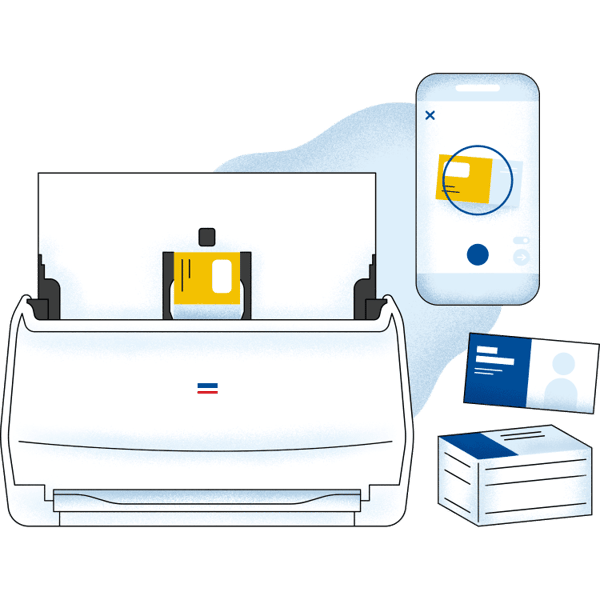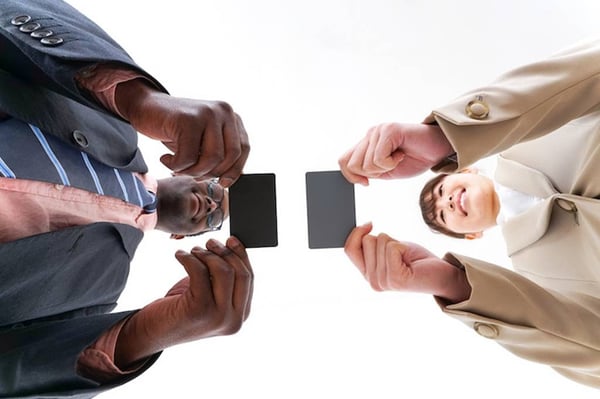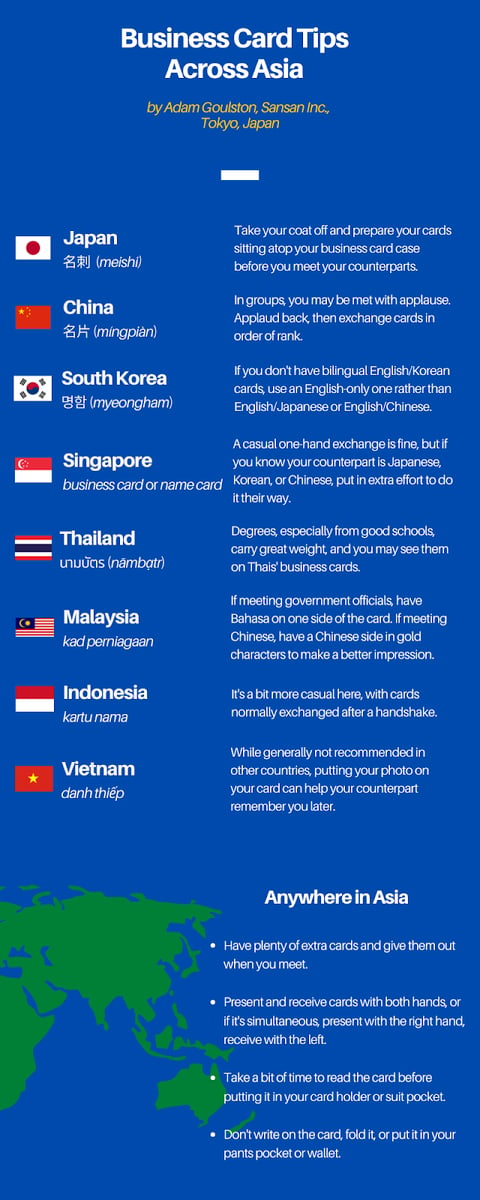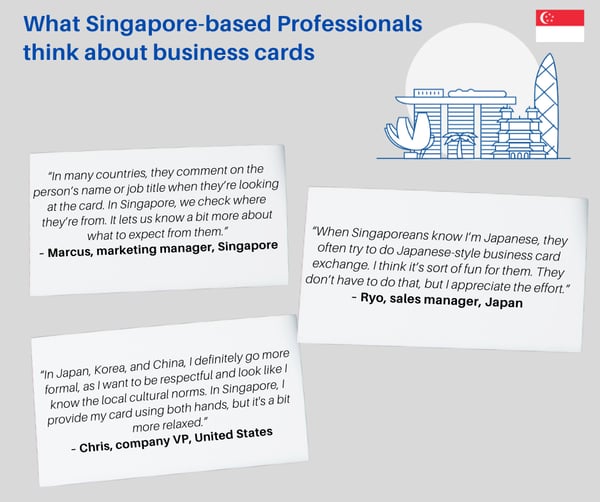March 17, 2020
 by Adam Goulston / March 17, 2020
by Adam Goulston / March 17, 2020

Exchanging business cards (or “name cards”) across with Asian businesspeople is a special dance that’s worth learning.
There are rules to follow and ways to get things off on the right foot – or a very wrong foot. It may look odd and impersonal if you’ve never done it, but it's rich with humanity and business potential. And “I’ll add you on LinkedIn” usually won't cut it.
Knowing the intricacies of Asian business card exchange can warm the relationship and show your emotional and cultural intelligence. How you treat the card itself can tip things strongly in your favor. Even if you’re not in Asia, there’s plenty to learn and apply.
Business cards matter in Asia – and if they don’t matter to you, maybe this article will shift your thinking.
The stat that states about 88% of business cards getting tossed within a week pops up a lot. Gary Vaynerchuk said business cards are “pointless,” just take out your [expletive] phone and email them right then and there. Sure, that makes sense in a transactional, assertive setting like New York (and more so if you’re doing business with Gary Vee).
But the thing is, many of the world’s people don’t jump straight into business, especially in the East. And email and SNS swaps are impersonal and get lost in the crowd of data.
Business cards are tangible, handed from person to person. They have symbolism and potential, even in 2020, and that’s a big part of why they retain their cachet in Asia.
Think about it: why would a business card have typos? It’d be worthless because no one could use it to get in touch with you. Company-issued business cards usually are in a standardized format, so you have your name, job title, company address, and so on.
SNS accounts are personally managed and chronically full of errors. Thumb-tapped texts have a naturally strong chance of typos. When an email address or phone number is one alphanumeric character off, it’s useless. Professional business cards are all 100% accurate. Of course.
The business card says, “This is me and I’m giving you permission to do business with me.” That’s first-party data, which is the best kind, because you know who gave it to you, when, and where. In the age of GDPR, that whole consent thing is a very big deal.
Contrast this with second-party data, which is data shared with you and for which the permissions are unclear. And with third-party data, such as purchased contact lists, for which the consent is unclear, you don’t know who else is using it, and the recipient didn’t ask you to market to them. Business cards? No problems there.
So you take that highly accurate, first-party data and throw it in the trash? Now that’s pointless! Hold on to those cards. Scan and digitize them to get them in your CRM. You can do this with a simple app or better yet with integration of a contact scanning and networking solution.
Even better, share these contacts with colleagues and create an integrated internal referral system where contacts are shared and coworkers can seek out leads and opportunities from in-company connections.
 Image courtesy Sansan Inc.
Image courtesy Sansan Inc.
In individualistic Western cultures, being assertive and striving for personal achievement are positive traits. Speaking openly about one’s ideas is encouraged. And younger people with fewer official qualifications or years on the job can be thrust into leadership positions or start their own companies.
In collectivist cultures, such as those in many Asian countries, businesspeople are more likely to earn their status through qualifications and tenure. A sharp youngster may have to wait their turn to lead. And keeping quiet may be valued over saying something foolish or upstaging their boss. This can confuse and frustrate those not used to it. Yes, it’s changing, but it’s nowhere near mirroring Western cultures, especially in the old-boy networks.

Whatever your thoughts on these tendencies (and they are generalizations, not rules), this is where the business card makes so much sense in Asia.
When an individual is less important than the group/company of which they’re a member, the business card clearly identifies their place. When someone gives you their business card in an Asian country, you know their name, where they work, their job title, who they represent.
This is why when someone gives you a business card, they give you a piece of themselves, a “mini-me” of sorts. Treat it as you would treat them. And view it as you would view them. Even in the West, 39% of people don't want to do business with people with low-quality cards. That speaks volumes.
Business cards in Asia are normally exchanged at the beginning of a meeting. In a group of businesspeople, it starts with the senior-most people and works down to the lowest-ranked.
With each introduction, a business card is exchanged and examined. Comments are made on relatively light things such the person’s job title, where they’re from, their academic degrees, their areas of expertise.
After this step, things fall into place, and you have a general idea of who can do what, who’s a potential decision-maker, who’s just along for the ride (such as admin or an intern).
Even among two people, the exchange quickly cuts to the core and lays some foundation for how this relationship may move forward. For younger workers, it can reduce pressure. For senior members, it can speak to their influence and ability.
If you look at the business card exchange process like the first step in dating or a courtship, it fits in quite nicely. Make a strong first impression, mind your manners, and show restraint and respect. In much of Asia, this is how you get off on the right foot, and it’ll work much better than 3 minutes of intense chat, taking out your [expletive] phone and dashing off a text or putting in WhatsApp.
If you’ve done business in Tokyo, Beijing, or Singapore, after a few interactions, patterns emerge. You’ll see varying degrees of the same physical actions. If you can grasp the fundamental aspects, you’ll be in good shape throughout the region.
This article refers mainly to East and Southeast Asia, as this is where business cultures and patterns have the most similar threads. South Asia (e.g., India, Nepal, Pakistan), as well as Australia and New Zealand, while part of Asia-Pacific, are beyond the scope here.
Japan, South Korea, and China – East Asia’s biggest economies – have the most formalized business card cultures. Understand and observe the following and you’ll be ahead in any of these countries.
There are some big no-nos as well:
Amid the similarities are some regional quirks. And Singapore shows what it’s like when all these flavors come together in the flesh and get down to international business.

Tiny Singapore (population: ~5.8 million) is where Asia’s many cultures come together to do business, often with Western cultures also in the mix. Singapore shows the best way to embrace this mix – relax, smile, play it by ear. Despite the country’s image as a law-abiding, somewhat stiff country, the people of Singapore can be delightfully outspoken and self-deprecating.
The island nation is a native mix of Chinese, Malay, and Indian. It’s also Southeast Asia’s premier business hub, with regional headquarters of multinationals like Panasonic, BMW, and Apple. This attracts businesspeople from all over.
As Chinese Singaporeans comprise about 75% of the locals, their influence on business card culture is most notable. But it’s a light version; Singapore can be very accommodating. If you fumble a business card exchange, it’s “OK lah.” Just don’t throw the card or fold it into an origami bird.

Singapore shows us that by exercising a bit of give and take with a pinch of emotional intelligence, a lot of business can get done. Achieving the world’s #38 economy (by GDP for 2020) isn’t bad for the #114 biggest country (by population). The food’s fantastic, too.
Times are indeed changing. You’ll find Japanese and Koreans and Chinese who are fine with swapping social accounts or using an app. Not everyone wears a suit. Some don’t bow at all. But if you get your boots on the ground in Asia and you get down to some sales meetings with medium- to large-sized companies, even very small ones, you’ll soon realize traditions continue, and business card exchange is often where business starts.
You don’t have to “turn Japanese” or “be un-[insert your nationality here]” to embrace it. Your efforts often won’t even be expected. So when you show sensitivity and realize what’s really going on in the business card exchange, you’ll start to benefit from it.
Then, when you have that card, and you’re not sure if you’ll ever do business with the person, try scanning it with an app and uploading it to your CRM or contact management system (CMS). You have permission to do business with the person. And even if you don’t, you may run into someone who wants to, and you can help them connect.
Good fortune’s in the cards for you in Asia.
Start any business interaction on the right foot with the best business card scanning software on the market. Find the solution you need today – only on G2.
Adam Goulston is a US-born, Tokyo-based digital marketer and writer serving companies, NGOs, and academia in multiple countries. Adam is the Content Manager at Japanese SaaS firm Sansan.
It’s not always easy to remember someone’s name. It’s even more difficult to remember what...
 by Daniella Alscher
by Daniella Alscher
Our society seems to think that handing out little pieces of paper with our names on them are...
 by Daniella Alscher
by Daniella Alscher
When was the last time you attended a business event and returned empty-handed? It's hard to...
 by Mayuri Bangar
by Mayuri Bangar
It’s not always easy to remember someone’s name. It’s even more difficult to remember what...
 by Daniella Alscher
by Daniella Alscher
Our society seems to think that handing out little pieces of paper with our names on them are...
 by Daniella Alscher
by Daniella Alscher




